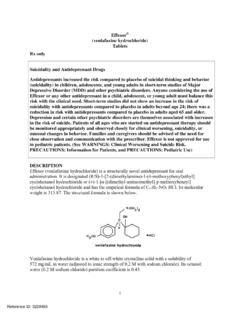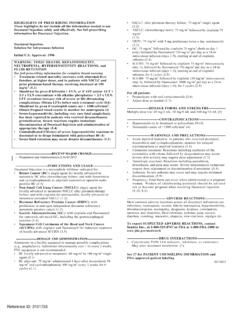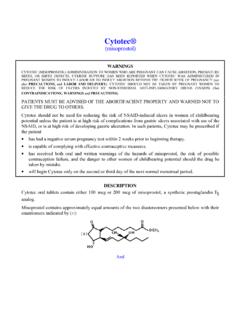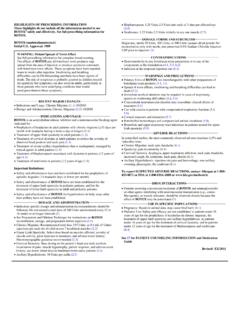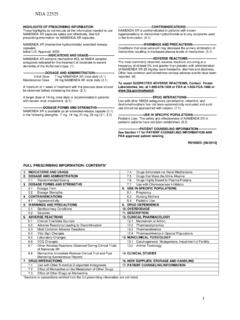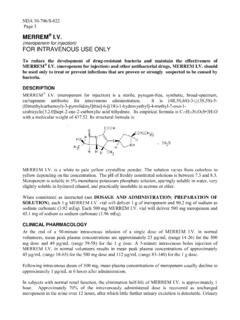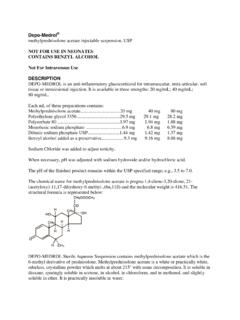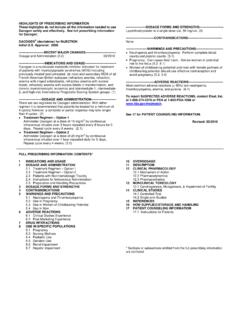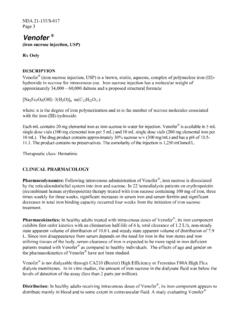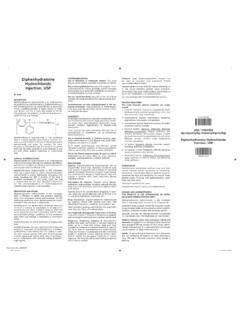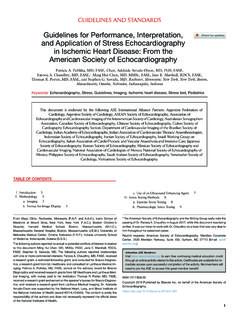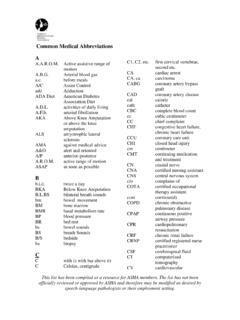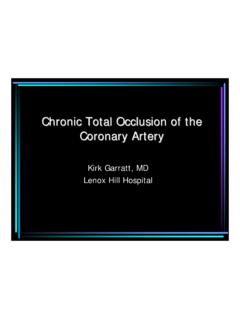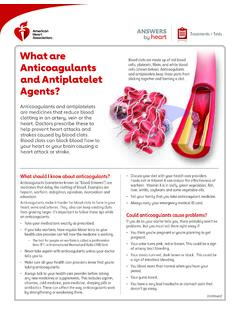Transcription of TORADOL ORAL (ketorolac tromethamine tablets) Rx
1 1 TORADOL ORAL (ketorolac tromethamine tablets) Rx only WARNING TORADOLORAL (ketorolac tromethamine ), a nonsteroidal anti-inflammatory drug (NSAID), is indicated for the short-term (up to 5 days in adults), management of moderately severe acute pain that requires analgesia at the opioid level and only as continuation treatment following IV or IM dosing of ketorolac tromethamine , if necessary. The total combined duration of use of TORADOLORAL and ketorolac tromethamine should not exceed 5 days. TORADOLORAL is not indicated for use in pediatric patients and it is NOT indicated for minor or chronic painful conditions. Increasing the dose of TORADOLORAL beyond a daily maximum of 40 mg in adults will not provide better efficacy but will increase the risk of developing serious adverse events. GASTROINTESTINAL RISK Ketorolac tromethamine , including TORADOL can cause peptic ulcers, gastrointestinal bleeding and/or perforation of the stomach or intestines, which can be fatal.
2 These events can occur at any time during use and without warning symptoms. Therefore, TORADOL is CONTRAINDICATED in patients with active peptic ulcer disease, in patients with recent gastrointestinal bleeding or perforation, and in patients with a history of peptic ulcer disease or gastrointestinal bleeding. Elderly patients are at greater risk for serious gastrointestinal events (see WARNINGS). CARDIOVASCULAR RISK NSAIDs may cause an increased risk of serious cardiovascular thrombotic events, myocardial infarction, and stroke, which can be fatal. This risk may increase with duration of use. Patients with cardiovascular disease or risk factors for cardiovascular disease may be at greater risk (see WARNINGS and CLINICAL STUDIES). TORADOL is CONTRAINDICATED for the treatment of peri-operative pain in the setting of coronary artery bypass graft ( cabg ) surgery (see WARNINGS).
3 RENAL RISK TORADOL is CONTRAINDICATED in patients with advanced renal impairment and in patients at risk for renal failure due to volume depletion (see WARNINGS). RISK OF BLEEDING TORADOL inhibits platelet function and is, therefore, CONTRAINDICATED in patients with suspected or confirmed cerebrovascular bleeding, patients with hemorrhagic diathesis, incomplete hemostasis and those at high risk of bleeding (see WARNINGS and PRECAUTIONS). Reference ID: 3281582 2 TORADOL is CONTRAINDICATED as prophylactic analgesic before any major surgery. RISK DURING LABOR AND DELIVERY The use of TORADOL in labor and delivery is contraindicated because it may adversely affect fetal circulation and inhibit uterine contractions. CONCOMITANT USE WITH NSAIDS TORADOL is CONTRAINDICATED in patients currently receiving aspirin or NSAIDs because of the cumulative risk of inducing serious NSAID-related side effects.
4 SPECIAL POPULATIONS Dosage should be adjusted for patients 65 years or older, for patients under 50 kg (110 lbs) of body weight (see DOSAGE AND ADMINISTRATION) and for patients with moderately elevated serum creatinine (see WARNINGS). DESCRIPTION TORADOL (ketorolac tromethamine ) is a member of the pyrrolo-pyrrole group of nonsteroidal anti-inflammatory drugs (NSAIDs). The chemical name for ketorolac tromethamine is ( )-5-benzoyl-2,3-dihydro-1H-pyrrolizine-1 -carboxylic acid, compound with 2-amino-2-(hydroxymethyl)-1,3-propanedio l (1:1), and the chemical structure is: Ketorolac tromethamine is a racemic mixture of [-]S and [+]R ketorolac tromethamine . Ketorolac tromethamine may exist in three crystal forms. All forms are equally soluble in water. Ketorolac tromethamine has a pKa of and an n-octanol/water partition coefficient of The molecular weight of ketorolac tromethamine is Its molecular formula is C19H24N2O6.
5 TORADOLORAL is available as round, white, film-coated, red-printed tablets. Each tablet contains 10 mg ketorolac tromethamine , the active ingredient, with added lactose, magnesium stearate and microcrystalline cellulose. The white film-coating contains hydroxypropyl methylcellulose, polyethylene glycol and titanium dioxide. The tablets are printed with red ink that includes FD&C Red #40 Aluminum Lake as the colorant. There is a large T printed on both sides of the tablet, as well as the word TORADOL on one side, and the word ROCHE on the other. CLINICAL PHARMACOLOGY Pharmacodynamics Ketorolac tromethamine is a nonsteroidal anti-inflammatory drug (NSAID) that exhibits analgesic activity in animal models. The mechanism of action of ketorolac, like that of other NSAIDs, is not completely understood but may be related to prostaglandin Reference ID: 3281582 3synthetase inhibition.
6 The biological activity of ketorolac tromethamine is associated with the S-form. Ketorolac tromethamine possesses no sedative or anxiolytic properties. The peak analgesic effect of TORADOL occurs within 2 to 3 hours and is not statistically significantly different over the recommended dosage range of TORADOL . The greatest difference between large and small doses of TORADOL is in the duration of analgesia. Pharmacokinetics Ketorolac tromethamine is a racemic mixture of [-]S- and [+]R-enantiomeric forms, with the S-form having analgesic activity. Comparison of IV, IM and Oral Pharmacokinetics The pharmacokinetics of ketorolac tromethamine , following IV and IM doses of ketorolac tromethamine and oral doses of TORADOL , are compared in Table 1. In adults, the extent of bioavailability following administration of the ORAL form of TORADOL and the IM form of ketorolac tromethamine was equal to that following an IV bolus.
7 Linear Kinetics In adults, following administration of single ORAL doses of TORADOL or IM or IV doses of ketorolac tromethamine in the recommended dosage ranges, the clearance of the racemate does not change. This implies that the pharmacokinetics of ketorolac tromethamine in adults, following single or multiple IM or IV doses of ketorolac tromethamine or recommended oral doses of TORADOL , are linear. At the higher recommended doses, there is a proportional increase in the concentrations of free and bound racemate. Absorption TORADOL is 100% absorbed after oral administration (see Table 1). Oral administration of TORADOL after a high-fat meal resulted in decreased peak and delayed time-to-peak concentrations of ketorolac tromethamine by about 1 hour. Antacids did not affect the extent of absorption. Distribution The mean apparent volume (V ) of ketorolac tromethamine following complete distribution was approximately 13 liters.
8 This parameter was determined from single-dose data. The ketorolac tromethamine racemate has been shown to be highly protein bound (99%). Nevertheless, plasma concentrations as high as 10 g/mL will only occupy approximately 5% of the albumin binding sites. Thus, the unbound fraction for each enantiomer will be constant over the therapeutic range. A decrease in serum albumin, however, will result in increased free drug concentrations. Ketorolac tromethamine is excreted in human milk (see PRECAUTIONS: Nursing Mothers). Reference ID: 3281582 4 Metabolism Ketorolac tromethamine is largely metabolized in the liver. The metabolic products are hydroxylated and conjugated forms of the parent drug. The products of metabolism, and some unchanged drug, are excreted in the urine. Excretion The principal route of elimination of ketorolac and its metabolites is renal. About 92% of a given dose is found in the urine, approximately 40% as metabolites and 60% as unchanged ketorolac.
9 Approximately 6% of a dose is excreted in the feces. A single-dose study with 10 mg TORADOL (n=9) demonstrated that the S-enantiomer is cleared approximately two times faster than the R-enantiomer and that the clearance was independent of the route of administration. This means that the ratio of S/R plasma concentrations decreases with time after each dose. There is little or no inversion of the R- to S- form in humans. The clearance of the racemate in normal subjects, elderly individuals and in hepatically and renally impaired patients is outlined in Table 2 (see CLINICAL PHARMACOLOGY: Kinetics in Special Populations). The half-life of the ketorolac tromethamine S-enantiomer was approximately hours (SD ) compared with 5 hours (SD ) for the R-enantiomer. In other studies, the half-life for the racemate has been reported to lie within the range of 5 to 6 hours.
10 Accumulation Ketorolac tromethamine administered as an IV bolus every 6 hours for 5 days to healthy subjects (n=13), showed no significant difference in Cmax on Day 1 and Day 5. Trough levels averaged g/mL (SD ) on Day 1 and g/mL (SD ) on Day 6. Steady state was approached after the fourth dose. Accumulation of ketorolac tromethamine has not been studied in special populations (geriatric, pediatric, renal failure or hepatic disease patients). Kinetics in Special Populations Geriatric Patients Based on single-dose data only, the half-life of the ketorolac tromethamine racemate increased from 5 to 7 hours in the elderly (65 to 78 years) compared with young healthy volunteers (24 to 35 years) (see Table 2). There was little difference in the Cmax for the two groups (elderly, g/mL ; young, g/mL ) (see PRECAUTIONS: Geriatric Use).
